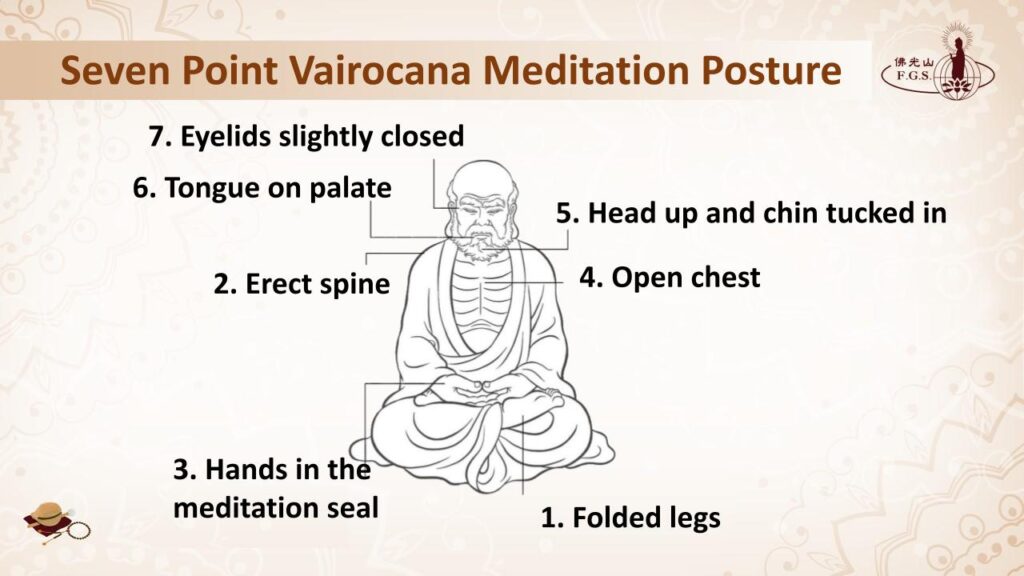
Speaker: Ven. Miao Tan
Fo Guang Shan Hsingma Temple, Malaysia
I. Introduction
Hi, good evening to all dharma friends online. Last weeks’ session I shared a brief introduction on Guide to Meditation, and today, I would like to prepare you for how to conduct a successful meditation.
An ancient saying states: “Good tools are required for the successful execution of a job.” Similarly, if a practitioner wants to sit peacefully, comfortably and without worry, it is necessary to prepare well before hand.
II. Before Meditation
It is important to know how to prepare yourself before practicing meditation
So, when you are ready to start your meditation, first make sure it is a comfortable environment. The place should be suitably lit, airy of moderate temperature and away from noise and disturbance.
Then arrange the cushion. Use a towel to cover the knees. If the weather is cold cover the head while sitting.
These essential points before meditation helps one to pay attention to the body.
Next, when you are ready to start meditation, there are seven points of meditation posture which is important because it sets the intention for your meditation practice.
III. Seven Points of Vairocana Posture

1. Folded legs.
Folded legs Folded or crossed legs refers to a full or half lotus pose. In full lotus both feet are on the opposite thighs whereas in half lotus one foot is on the opposite thigh and the other foot is underneath the opposite leg.
Whether sitting in full or half lotus, one must feel stable and comfortable. If one is not numb or in pain in the lotus posture, one can sit for a long time without tiring, thus can develop the august manner of “sitting like a bell”.
Even if it is difficult, sit as long as comfortable, relaxing when necessary. However, if it is too difficult do not force it. Meditation time should not be too long; about 20 minutes per session or until the mind is peaceful. Slowly, you can train yourself to sit for longer period.
2. Erect spine.
The spine supports the upper body from the head to the tailbone. When the spine is erect, the nervous and vascular systems are straight and energy flows easily.
When the body and mind feel pleasant and comfortable it is easy to sit for a long time.
If the waist is bent and the back is hunched, the internal organs are under pressure and internal energy and blood flow are blocked, leaving the mind either racing or dull and sleepy. Also, please note, do not expend too much effort on straightening the spine or the body, it will become tense and rigid and one’s meditation will be ineffective. The correct way is the middle path between too relaxed and too tense.
3. Hands in Meditation Seal.
The arms are naturally relaxed and hanging down, left hand atop the right with palms up. The thumb tips lightly touch, forming an ellipse. Gently rest the hands on the lap with the elbows a little away from the body. Because the hands are joined, the energy can flow freely, making for a stable posture and peaceful mind.
4. Straight shoulder and chest.
When the body is upright, straighten the chest and drop the shoulders. [Slide 12] Relax the shoulder muscles, leaning neither left nor right. If one is bent or hunched, the shoulders will tend to hunch forward, constricting the chest. If one is tense, pushing the chest too far forward, breathing evenly will be difficult and the mind will not be peaceful.
5. Upright head, tucked in chin.
Straighten the neck and gently tuck in the jaw, to aid in developing a deep, long breath. It will also help the energy to flow easily.
6. Tongue resting on palate.
Gently close the lips and let the tongue tip lightly touch the upper palate behind the top teeth. The nerves of the tongue are extremely sensitive, so do not use force.
If saliva is produced just swallow it as it is good for the digestion and promotes good health. It is very beneficial to always keep the tongue in this position
7. Eyes slightly closed or slightly opened.
Eyes are the first of the six senses and the spring of the mind. They are easily affected by the external environment, which in turn disturbs the clarity and peace of the mind. Therefore, do not open the eyes completely. But, with the eyes closed, it is easy to fall into dull and delusive states, so open them a little. Direct the gaze along the nose into the space in front and keep the eyes still.
If the eyes feel tired, close them for a little rest. Reopen them when comfortable. Some meditators keep their eyes closed whilst meditating. This is fine, as long as one does not feel dull, drowsy or have wandering thoughts.
These are the 7 important points when practicing meditation. It is an ancient practice of all sects and schools of Buddhism and is used in all methods of meditation and energy training.
IV. Incorrect Sitting Position
When we practice meditation, we must avoid these incorrect postures such like:
Head aslant, face askew, tilting up or down, bend waist, hunched back, body all awry, back leaning against the wall and hanging legs. Therefore, it is important to check these few postures before meditation.

V. Before Meditation
You may do yoga or some body stretching exercise, when you are ready for sitting meditation, loosen the belt if any, remove the jewelry, watch or bracelet, this will allow the blood to circulate freely and the body to be comfortable. Cover the knees with towel particularly in cold weather.
If your body is tired and stressed, or negative emotions, excessive toxins will accumulate in your body, it is beneficial to take a deep breath and then exhale all the impure air before sitting in meditation. Having a light diet before meditation, will also help your body and mind to attain a relaxed state in a faster pace.
There are three basic meditation practices what will help you to achieve calming and relaxing mind: Relaxation Meditation, Breath Counting Meditation and Breath Observation Meditation are the main practices.
VI. After Meditation
Many beginners ignore stretching before sitting. This hinders progress and impedes success. Others neglect exercise after meditation, this results in physical discomfort in future meditations. Therefore, it is necessary to stretch the muscles before sitting and it is also necessary to exercise afterward, in order to help the body return to its normal state of activity.
VII. Ten Benefits of Meditation
If one practice meditation correctly and diligently, one will benefit from:
- Physical illness will be cured.
- Life will be prolonged.
- Physical health will improve.
- One will enjoy peace and tranquility.
- One’s heart will be joyous.
- One will feel love and compassion for humankind and the heart will be happy and at peace.
- One will overcome the afflictions and anxieties of life.
- One will gradually eliminate past karmic obstructions of body, speech and mind.
- One will awaken from the belief in good and evil. In the awakened state there is neither thought nor absence of thought. Henceforth one will never again be lost, confused or deluded or seek for external satisfaction.
- One will attain the Buddha way and attain perfect wisdom, knowledge, kindness and compassion.
VIII. Essence of Meditation
Essence of meditation is Awareness that you know what you are doing, thinking and feeling. Realizing the mind without desire, one becomes a free spirit. Meditation is learning to continuously accept the good and bad in ourselves and other people.
XI. Conclusion
For beginners, it is important to prepare yourself by attending to these few points before each sitting session. If each is done properly, one can progress, attaining peace, comfort and the joy of meditation.
Buddha once said, “sitting meditation can make us feel the presents of Joy.” The so-called presents of joy, which is a kind of wonderful joy from the silent heart, and it can be attained by diligent practice.
I hope with these guidelines will help you to achieve physical and mental peace and in a state of mindfulness. Thank you. If you like our channel, you may subscribe so that you will not miss any episode.

